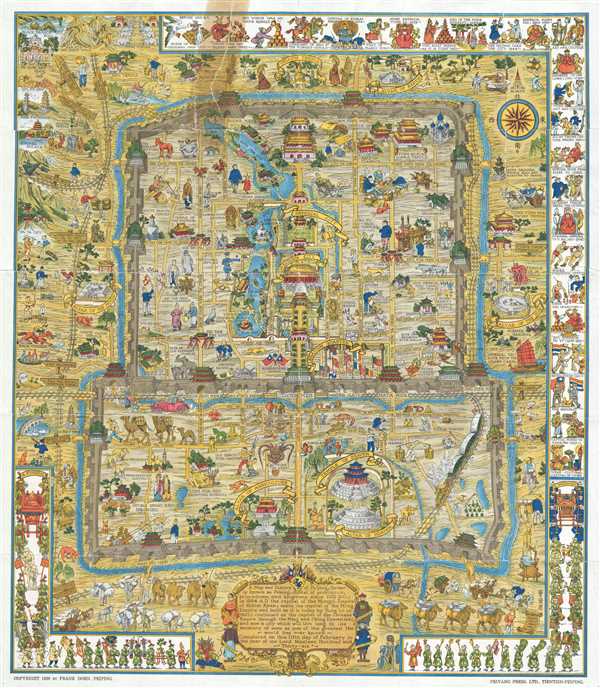
This item below is out of stock, but another example (left) is available. To view the available item, click "Details."
Details
1936 Frank Dorn Pictorial Map of Beijing or Peking, China
$2,500.00
1936 Frank Dorn Map of Beijing or Peking, China
BeijingPeking5-frankdorn-1936
Title
1936 (dated) 33 x 29 in (83.82 x 73.66 cm) 1 : 15840
Description
This map is Dorn's only cartographic production and grew out of his fascination with Chinese history. The preface to his 1970 book The Forbidden City: The Biography of a Palace, Dorn describes the inception of this remarkable map:.
I developed an interest in the Forbidden City and other imperial residences, first from casual sightseeing and then from conducting important visitors and tourists through the palaces. A growing familiarity with the buildings and courts soon became an absorbing urge to learn more about the history and legends connected with those who had created and lived within the walls of the palace-city. The first result of my researches was a pictorial map of Peking, after which I was completely hooked on the whole fascinating subject.
Dorn's inspiration in creating this map may well have been the work of California artist Jo Mora (1876-1847), with whom he was a friend and admirer. The whimsical style, bright colors, and overall design is certainly highly reminiscent of Mora's work.
This map was published in Tientsin and Beijing, China by the Peiyang Press, in 1936.
Cartographer
Frank 'Pinky' Dorn (June 25, 1901 - July 26, 1981) was an American artist,'old China hand,' and military officer active in East Asia during the middle part of the 20th century. Dorn was born in San Francisco California and later studied at West Point after which he was commissioned in the Field Artillery. He served in the Philippines from 1926 to 1929 and became an instructor at the Field Artillery School at Fort Sill from 1930 to 1933. It was there in 1931 that his produced his first pictorial map, detailing Fort Sill. Between 1931 and 1936, he completed additional pictorial maps of For McKinley and Fort Stotsenburg. Dorn was stationed in Beijing in 1934 where he studied Chinese. It was during this period that Dorn made his greatest contribution to cartography, his iconic pictorial Map and History of Peiping. Dorn's important maps, issued from 1831 to 1936, followed in the artistic-cartographic style of Jo Mora (1876 - 1947), with whom he was acquainted and whose work he admired. During World War II (1939 - 1945) he was assigned as an aide to Brigadier General 'Uncle Joe' Stilwell in the Burma theater under whom he served from 1939 - 1942. There is some indication that Dorn may have served as a field cartographer under Stilwell, but none of these maps are known to have survived. After the war, he was elevated to the rank of Brigadier General and served from 1944 to 1945 as the commander of the China Training and Combat Command. Dorn retired 1953 and returned to San Francisco where he devoted the remainder of his life to painting. He got involved with the psychedelic movement and produced a number of paintings to this effect. Dorn died in 1981 and was buried with full military honors at Arlington National Cemetery. More by this mapmaker...

